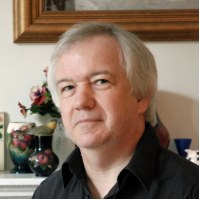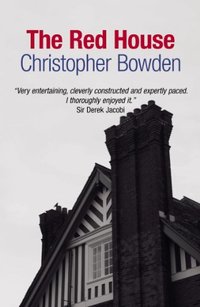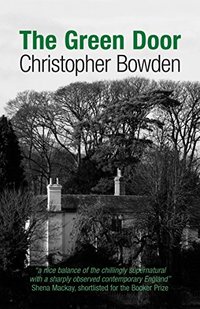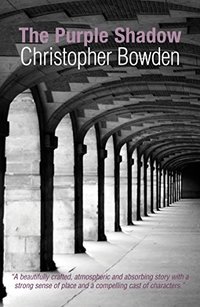Christopher Bowden Interview Published on: 11, Jun 2018
 Where did you grow up? What has its impact been on your writing?
Where did you grow up? What has its impact been on your writing?
I was born in London, grew up near there and have lived back in the capital for the last forty years. The books certainly draw on London settings but go much wider to other parts of the UK and abroad. The Yellow Room, for example, has a section in Kenya, where I worked for a while, and The Purple Shadow is set mainly in Paris, which I often visit.
All your novels have a color theme. What is the story behind this?My first novel (The Blue Book) was so-called because it featured a book with a blue cover that is at the heart of the story and I liked it as a title. It then occurred to me that the colours approach would be an attractive way of developing other novels so I decided to complete the primaries with yellow and red before moving on to the secondaries (green and purple so far). The choices are not arbitrary, though. The title colour of each book is related to its plot and themes.
What inspires you to write?I write because I enjoy the creative process, getting from the blank page to the completed book. The use of language, characterisation, settings and plot and how the interaction between them sheds light on the themes of each book. And I have to keep going to find out what will happen; it’s not all mapped out from the start.
Are your characters inspired from real life people or completely a fragment of your imagination?The characters are fictitious – figments of my imagination – and do not correspond to real individuals. But imagination does not exist in a vacuum and I necessarily draw on my experience of types and characteristics of people I’ve encountered in one way or another over the years.
All your books are mystery and suspense stories. What is it about the genre that you feel drawn to it?I like writing fiction that develops and explores the plot and themes through mysteries in the form of problems to be solved. These vary from book to book. They involve detection on the part of the main protagonists but there are no detectives in the conventional sense. There are no policemen in the books. There are no criminals to be caught, which is not to say that no crimes take place. That’s part of the mystery!
How did you come up with the plot for The Blue Book?The Blue Book started with just a single idea: somebody finding something hidden inside a second-hand book that would lead them to do something or find something or someone. I have collected second-hand books for a long time. I often find things slipped inside - postcards, bus tickets, chocolate wrappers. This gave me the idea of someone finding a mysterious note hidden between the pages of a book, setting them on a trail to discover the meaning of the note and the identity of the person who wrote it, uncovering secrets, lies and deceptions along the way.
The Yellow Room has a historical theme at heart. What is it about the history of Britain that you found so attractive?The Yellow Room features at its heart an English country house and the family that lives or used to live there. We see the place both in the present day and in the 1950s, focussing on the run-up to the Suez Crisis in 1956. What emerges is a picture of a landed family fighting to stem the decline in its own fortunes in a post-war world in which Britain’s own role is steadily declining.
Your third book, The Red House, has the most interesting title. Can you throw some light on its relevance?The Red House of the title is a fictitious house on the east coast of England. From the outside, it looks solid and respectable; inside, it is a different story. Red signals that the house is a place of danger. Our hero goes there on a mission, thinking that the initiative is his. In reality, he has been lured to the place, with bizarre and unpredictable results.
The Purple Shadow is set in the theatre worlds of Paris and London in the 1930s. Were you ever associated with theatre?I have no theatrical experience, other than the odd school play years ago, but I am a keen theatre-goer. Actors and acting feature in several of the books, notably The Red House. The Purple Shadow builds on that interest (with the same protagonist) and takes us back to the 1930s as background to the events which unfold in the present day.
Did you originally plan to be a writer? What were your other career options?I have a murky past as a civil servant and only turned to creative writing later when I realised that that was what I really wanted to do.
Were you an avid reader since childhood? Which was your favorite genre and book?I’ve always been a keen reader but my tastes have changed and broadened over the years. I tend to read literary fiction, ranging from modern American authors, like Paul Auster and Richard Ford, to quintessentially English ones, such as Barbara Comyns and Barbara Pym, Jane Gardam and Penelope Lively, William Boyd and Ian McEwan. A bit of crime fiction by the likes of PD James and Dorothy L Sayers – and many of the Noir Series published by Akashic Books. ‘Strange’ or supernatural fiction is also an interest, from the ghost stories of Edith Wharton to the strange tales of Reggie Oliver.
The protagonists in your books are always in the search of something. Is that a concept you relate with in your personal life?No, it’s essentially a plot device, a search with unexpected consequences kickstarted by something found or lost. I find it’s a good way of developing and maintaining momentum, even if there are set backs and occasional blind alleys.
Share Christopher Bowden's interview
Author Christopher Bowden was born in London and glimpses of the city and others where he worked or visits often can be seen in his books. Interestingly naming all his novels after colors, Bowden enjoys the process of converting a blank page into a complete book. A collector of second hand books from a long time and finding things like notes and postcards slid inside them, he took inspiration from this idea to write his first novel, The Blue Book. A civil servant with a murky past, Christopher moved to creative writing when he realized this is what he wanted to do. Spinning mysterious plots without detectives and policemen, and relating each book’s title color to its plot, The Purple Shadow is Christopher Bowden’s latest release. Bowden enjoys going to the theater and reading literary fiction, crime, and supernatural apart from writing stories where there are problems to be solved.






